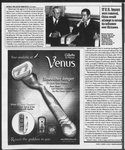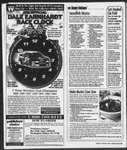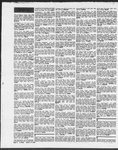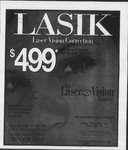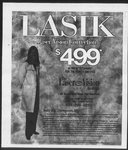| OCR Text |
Show AAG The Salt Lake Tribune OPINION Greener, Service-Based Future Gives Many Students Anxiety BY EDWIN R. STAFFORD My mostcontroversial lecture every semester is my discussion of how environmental concerns may ‘affect marketing ice and consumer behavior in the 2ist century. At the heart of the issue are property rights and the American value of “ownership.” Yet, a widely touted vision about how products will be sold seems to spark such emotional responses from my marketing students — some of tomorrow’s marketing leaders — thatI believe environmentalists and businesses need to evaluate how they'll sell a “one-time-use” cameraexemplifies product take-back. Its name is really a misnomer as users send in the entire camera for film processing, and the camera is then refurbished with new film for resale. One-time-use cameras make good business sense because they're convenient for consumers, and their efficient reuse reduces manufacturer expenses. The take-back trend is motivating many companies to retain ownership of their products and create service lease arrangements for their customers. Sunday, March 11, 2001 DCES and it hurts those of us trying to help the children. Not Lurking In Corners To improve efficiency, Gateway Computers and Xerox are capitalizing on the service lease concept, selling the benefit to consumers that they mayturn in outthe latest techprohibitive Swedish appliance maker Electrolux is taking the service-lease eee Continued from AA-S SS for many ofus to champion those rights. Sometimes there are happy endings, sometimes the endings are tragic. Sometimes whatis best for all concerned is reunification. Sometimes whatis best for the child is the termina- conceptonestep further. In an ex- periment, Electrolux is literally giving away its washers and dryers and then charging consumers based on actual usage monitored See FUTURE, Page AA-7 bestfor the child does not happen. Sadly, there are instances where the parents’ demands are met at the expense ofthe child. And then there are times the children don’t consultants and dedicated, welltrained peer parents. There is the Foster Care Foundation, a superb, independent resource for foster families. There are volunteers who sit on the Foster Care Citizen Review Board, who are volunteers whofreely give their time and best efforts. There are advocacy groups like Utah Children and Prevent Child Abuse Utah who work Is the system perfect? Of course not. However, I know there are people both inside and outside the system championing for improvements. I know there are people working to makeit better. 'm a very passionate, dedicated one of them. We could use your help. Theprocess is slow and change takes time. It also takes peoplevolunteering.It takes people spending their energy improving rather than criticizing, people putting aside their private agendas and working together. ‘The children deserve our best efforts. What we need are fewer fingers pointed and more hands extended. Lorna B. Rosenstein is a foster Parent who lives in Layton, greenerfuture to society. I like to be provocative in class. It piques studentinterest in what sometimes are rather mundane subjects in marketing. Indeed, discussing environmental issues among conservative Utah students can frequently spark strong reactions: “Professor Stafford is a wacko tree-hugger!” However, the growing political, economic, and consumer demands for greener and cleaner technologies and practices cannot be denied. I ask students to ponder what'slikely to happen to the planet’s quality of life when onebillion Chinese trade in their bicycles for cars in the coming decades. Discussing specific examples of Utah's air and water quality problems andtheir ill effect on our own health and welfare makes environmental issues personally relevant. But mylecture isn’t all doom and gloom. The moral is that becoming greener and cleaner creates “enviropreneurial” business opportunities for innovation, new marketable technologies, and cost savings thatinevitably can benefit profits, the environment, and society — commonlycalled the “triple bottom line.” Such emerging technologies as wind-generated power, fuel cell cars, and McDonald’s _soon-to-be-announced biodegradable “earthshell” packaging madefrom potato starch and limestone are model examples of howbusinessesare capitalizing on our need for a greener and cleaner future. Whatputs students at unease, however,is the assertion that to- Seven generations have been born at St. Mark’s Hospital. Notonly is St. Mark’s Utah’s first hospital, but with the recent opening of the Women’sPavilion,it is also the area’s newest women’s hospital. morrow’s greener economywill be significantly more servicesoriented. That is, we won't own our golf clubs, carpets, televisions, washing machines, and cell phones. Rather, we'll simply lease them, paying periodic or per-use fees and returning the products back to manufacturers when we're done. In short, we'll pay for the services provided by goods rather thanfor the outright ownership of them. Howis this greener? Leasing products closes the resource loop. Underour present “ownership” system, consumers are responsible for disposing of their obsolete products, Increasingly, this is problematic. Here in Utah, many simply cast off their old comput- With that mix of tradition and new technology, it’s no wonder St. Mark’s Hospital receives -star ratings in Obstetrics from Healthgrades.com* Be sure to choose a healthcare provider thatwill deliverYou babyat the Women’s Pavilion at St. Mark’s Hospital. ers, broken VCRs, and worn-out furniture as “charity”to the local DeseretIndustries. Or they turn to “public” dumpsters at the local St. Mark’s Hospital accepts most health ward or park, Quite frankly, it isn’t ethical to force the church or taxpayers to dispose of people's insurance plansincluding: Altius Health garbage. Yet, for many, this seems to be the convenient option. Plans, CIGNA, Regence BlueCross Eventually, old products end up in landfills, which steadily are reaching capacity. Sure, there's plentyof open land to dump future BlueShield, CCN, and PEHP. garbage, but with the not-in-mybackyard mentality of most com- munities, it’s difficult to find new landfill sites, and people are averse to paying to have their garbage exported out. The landfill crisis isn’t only about space, however. It is also about public health. The pace of new technology is tightening the replacement cycles of many prod- ucts, such as computers, cell phones video games, and other electronic gizmos. Electronic waste is a major public safety issue. The National Safety Council 72 , Utahss newest womens hospital predicts that around 500 million computers will becomeobsolete by 2007, and most will end up in the landfill. Computers and other electronics are banded cocktails of dangerous chemicals and metals. Indeed, about40 percentofall lead in *Healthgeades.comis anindependent nationalrating firm. ‘Their goal is to provide information’ to. consumers to he'p them select the best quality hospitals, physicians andhealthplans landfills come from junked computer and TV monitors, The bottom line is that con. sumers aren't capable of making the right choices for disposing of their outmoded product id they shouldn't be held responsible. Instead, businesses should. The new wisdom is: “If companies makeit, they should take it!” This is moti vating product“take-back”lawsin Europe that require manufactur. ers of big-ticket items, such asrefrigerators and carpets, to take their products back for recycling to close the resource loop. Though still in its infancy, product take-back is forcing man: ufacturers to reengineer their products for easy disassembly,re cycling, and reuse. The Women’s Pavilion at St. Mark’s Hospital CARE MOUNTAINSTIAR HEALTHCARE 1200 East 3900 South ¢ Salt Lake City 801.268.7111 www.stmarkshospital.com Other affiliates of MountainStar Healthcare include: Brigham City Community Hospital * Ogden Regional Medical Center Lakeview Hospital in Bountiful * Timpanogos Regional Hospital in Orem * Mountain View Hospital in Payson |







































































































































